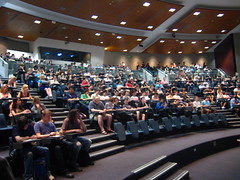
This is the second part of a three-part recollection and reflection: "On choosing to teach: a professor reflects", by Peter Mellalieu. To read part one, please click this link.
INTRODUCTION
In the first part of this series I outlined the events that led to my 'call to teach' at Massey University in the late 1980s. I recalled the earlier influences on my life such as the two innovative teachers I had as parents, and my experience tutoring fellow students at high school and university. I concluded with my arrival at the university and induction directly into the team marking about 1000 first year business studies examination scripts.
In this episode, I recall my anxiety and preparation for my first lecture followed by the logistical catastrophe of my first on-campus programme. I include reflections on the approaches I took to establishing and developing my personal approach to curriculum innovation and development.
PART TWO
A visit to the mentor: speaking partners
Arriving at the university in October 1987, several months loomed before my first Management lecture in March to an estimated 200 second-year students of business studies. Anticipating my first class was a cause of much anxiety on my part. Fortunately, a colleague and I became 'speaking partners' soon after my arrival. We embarked on a commitment to weekly discussions to support each other's professional development. As an early joint exercise we created a statement of our personal teaching philosophies. My statement continues to evolve and inform my teaching practice. Furthermore, it warns students what to expect from my classroom environment. My speaking partner was a lecturer in communications. Consequently, she was well able to assist my confidence-building through having me practice and demonstrate elements of lecture writing and delivery. (Thank you, Marianne.)
An aside: A student pointed out to me recently that all he wanted from my course was what I might term a 'certificate of attendance' ... he seemed not to want to prove that he had learned anything, nor gains competencies that might help him 'get ahead'. I reminded the student that he was attending a tax-payer funded institution that had certain obligations to achieve nation-building outcomes ... whether he liked it or not! That conversation reminded me of the importance of stating up front clearly my teaching philosophy to students early in their study with me. I suggest it's also a good idea to share your teaching philosophy with colleagues - especially if your approach is out of the ordinary stream of students' - and teachers' - experience.

Image source - by sobriquet.net
Crossing the threshold: my first lecture
I began my first lecture by asking a student picked at random from my class list to respond to the question I had written on the blackboard (real black, real chalk) about 10 minutes before the class commencement. In a subsequent class the answer 'meaningless' was proffered in response to my request for the most important word in a quote by Jean-Paul Sartre introducing the contingency approach to management studies: "Life is absurd, contingent, and meaningless". I took the high ground in the first seconds of my engagement!
Lectures took much time to prepare: texts did not yet come with Powerpoint slides, prepared multi-choice tests - or even acetate slides. Fortunately there was an instructors manual for the course text to provide guidance for case study discussions. Instructors manuals are useful 'trainer wheels' for the novice teacher! I must admit to considerable anxiety embarking on facilitating case study discussions. What if the students came up with different answers than those in the instructors manual? What if they asked questions to which I didn't know the answer? I later learned the teacher's trick: "Now, Julia, what is your response to that question?".
Mid-year, a proportion of my 400 extra-mural students arrived during the study break for their two-day on-campus experience. Our current manic rush of the 14-week semester had not yet been inflicted on students who must also balance their career and family lives with their engagement with the academy! The on-campus programme included samples of the weekly lectures case study discussions, a test, and tutorial exercises provided to the intramural students. Discussion around the book - and video - 'Theory K' was a highlight for two years (Inkson, Henshall, Marsh, & Ellis, 1987). My use of these resources persisted until several of the high-profile 'excellent' companies (Judgecorp? Chase?) fell into bankruptcy or disrepute after the share-market crash of October 1987. The Hannovers and Bridgecorps of yesteryear! Those earlier companies' fall replicated the parallel fall of several companies profiled in Peters and Waterman's US precursor to 'Theory K': 'In Search of Excellence' (Peters and Waterman, 1982). That book had so excited me whilst on my 1983 post-doctoral position at Massachusetts Institute of Technology, and informed - briefly - one aspect of my approach to strategy teaching. In Cambridge (US) I saw and experienced some of those excellent companies in action - and many others. Quite a contrast to the Muldoonist state-cocooned 'enterprise' that then pervaded New Zealand in both the state and private sector.
In later years, through meeting with British business anthropologist Professor Andrew Pettigrew of Warwick University, I learned of the deficiencies of the one-sided uncontrolled study of 'excellence' and 'leadership' exemplified in Peters and Waterman, Theory K, ... and several other copy-cat studies. These deficiencies lead to the rise of 'matched case' research studies. Pettigrew and Whipp's (1993) thorough and exciting qualitative approach was adopted by my first PhD 'student' who studied the adoption of advanced product design and ergonomics principles in several New Zealand companies (Slappendel, 1992). I state 'student' parenthetically as I learned more about qualitative research and Pettigrew's approach from my student than I was able to offer in return. I believe my contribution was merely to protect my charge from quantitative researchers concerned at the absence of statistical rigour emanating from a study based on eight cases. Nevertheless, I supervised several masters theses that soundly embraced Pettigrew and Whipp's matched case approach.

Image source - by Andrew Scott
The road of trials: soliciting feedback from students
My first on-campus for extra-murals in 1988 was a logistics disaster. I learned that once you post out your schedule of events to your colleagues and guest lecturers YOU DO NOT ALTER THE PLAN.... My revised, 'improved' plan lead to double bookings and geographically misplaced teachers amongst the dozen or so teachers involved. Based on pre-emptive advice from a colleague I had fortunately arranged for students to complete a feedback form that gave me precise data that guided my improvement of the two remaining on-campus experiences for the remaining cohorts of extra-mural students.
The second course, delivered in Christchurch, went very well. Relief! But that was just a small group of 60 students. The final test was how a much larger cohort of students in Auckland would experience the new recipe. Again: excellent. I had learned another lesson: timely soliciting of student feedback and using that promptly to improve teaching operations. Don't wait to receive end-of semester student evaluations of teaching. They don't help the students in your current class. They are out-of-date. And often they are taken mid-way through your course when students are often at their highest levels of stress and anxiety.
In my current teaching, I provide a weekly opportunity at every class for my students to express suggestions for improving their state of confidence about the class. I measure the degree of 'Csikszentmihalyian Flow' of my students at both the start and end of each class. It is a five minute exercise that helps students realise they are not alone if they feel anxious or worried about the class. The instrument helps students identify that there are others in class from whom they can get help - those who declare they are 'in control' or in 'flow'. I also ask students what they propose I can do do mitigate their challenges with the course. Using the Csikszentmihalyian Flow-o-meter is especially valuable if, like me, you adopt out-of-the-norm teaching approaches. Or if you are uncertain about students' response to your teaching approach. Personal risk management!
Another instrument I use to gain valuable ideas for improving future deliveries of a course is a de Bonofied variant of the Small Group Instructional Diagnostic - SGID. I facilitate a PMI discussion of the features of the course: Positive, Minus, and Interesting (a de Bono lateral thinking technique). Finally, for each feature, the students provide advice about whether to increase, decrease, or modify the feature in some way. For an example of SGID in action see the video in Mellalieu, 1997. In this case, the SGID occurred following week three of the most innovative course I have ever created: the final year undergraduate course Innovation, Creativity and Entrepreneurship (ICE) at Massey University, 1996-1999. My motivation for commissioning the SGID was to gain assurance that I was on a 'safe' track in terms of the radical pedagogy I was deploying: a hybridised master-class, as-live-to-air reality TV edu-trainment called Enterprise MasterWorks.
Consequently, I commissioned an external facilitator to lead this - my first - SGID session. A reflection of the entire course journey for Enterprise MasterWorks/Innovation, Creativity and Entrepreneurship is in Mellalieu (1998).

Image source - by atmtx
In my first year of teaching, my final year course in Business Policy was a delight to teach to a small class of 12 students. I made weekly use of 'The Case Study' approach in which students diagnose the problems faced by a business within the context of industry trends and competition. My students warned that I would be facing an insurge of students the following year based on their recommendations. I was surprised to find 40 students the next year. By 1991 my Business Policy class - renamed Strategy, Policy, and General Management - had grown to around 80 internal and 80 extra-mural students. At my instigation, I was relieved of the high administrative workload Management course.
The strategy course evolved under my direction to become an exemplar of excellence for extra-mural teaching. I'm proud to note that one student gained an award from the NZ Strategic Management Society for a case study they wrote describing and evaluating a strategic initiative undertaken by a New Zealand organisation. The study considered the Air New Zealand corporate take-over of Ansett Airways, if I recall correctly, written by an airline pilot/extra-mural student at 30,000 feet. The relief from the low level undergraduate teaching also gave me the chance to concentrate on developing new - and later innovative - courses at postgraduate level.
Just this week I met a former extra-mural student of my Massey Strategy course. My student is now the 50 per cent owner/operator of a steel roof manufacturing company. By serendipity, I was visiting the company in my role as an amateur photo-journalist commissioned by my brother and his business partner to photograph a sheet steel decoiling system they had invented and built for sale to my former student's business. He recalled how interesting and well-organised the course was, and the value of the case study approach. I suggested the opportunity to write a case study about my student's current business choices as he considered expansion of his business!
Preview of part 3
In part 3, I look at the advancing of my teaching practice, along with the importance of diversity, innovation, and information and communication technologies such as pedagogical games, decision support systems, the electronic text book and collaborative learning technologies.

Image source
Peter Mellalieu
Peter J. Mellalieu is a curriculum innovator who teaches innovation, entrepreneurship, strategy, creativity, and sustainable enterprise development at Unitec Institute of Technology, Auckland, New Zealand. He studied industrial engineering and management at Massey University (BTech (hons), 1973-1976) and public policy at Victoria University of Wellington (MPubPol, 1976-78). His doctoral studies in management science and information systems (1979-1982) engaged him implementing decision support systems for strategic planning in several agribusiness sectors. He is an ardent advocate for education for sustainability. His professional journal is at http://pogus.tumblr.com and resources for teachers and students at http://teach.myndsurfers.org.nz.
Related articles
- INVITED BLOGGER OF THE MONTH: On choosing to teach: a professor reflects (Part 1) (ictelt.blogspot.com)





No comments:
Post a Comment